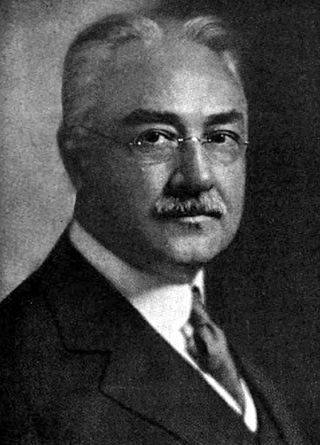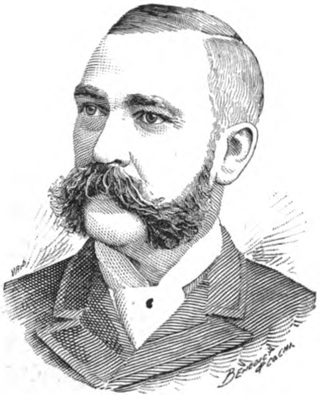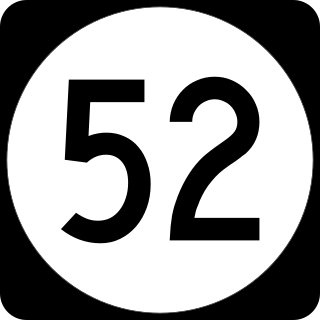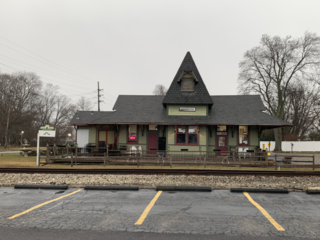
Wilmington is the largest city in the U.S. state of Delaware. The city was built on the site of Fort Christina, the first Swedish settlement in North America. It lies at the confluence of the Christina River and Brandywine Creek, near where the Christina flows into the Delaware River. It is the county seat of New Castle County and one of the major cities in the Delaware Valley metropolitan area. Wilmington was named by Proprietor Thomas Penn after his friend Spencer Compton, Earl of Wilmington, who was prime minister during the reign of George II of Great Britain.

Barberton is a city in Summit County, Ohio, United States. The population was 25,191 at the 2020 census. Located directly southwest of Akron, it is a suburb of the Akron metropolitan area.
Smurfit-Stone Container Corporation was a global paperboard and paper-based packaging company based in Creve Coeur, Missouri, and Chicago, Illinois, with approximately 21,000 employees. In 2007, Smurfit-Stone was ranked 13 in PricewaterhouseCoopers' "Top 100" forest, paper, and packaging companies in the world as ranked by sales revenue. The company was also among the world's largest paper recyclers.

Brandywine Creek is a tributary of the Christina River in southeastern Pennsylvania and northern Delaware in the United States. The Lower Brandywine is 20.4 miles (32.8 km) long and is a designated Pennsylvania Scenic River with several tributary streams. The East Branch and West Branch of the creek originate within 2 miles (3 km) of each other on the slopes of Welsh Mountain in Honey Brook Township, Pennsylvania, about 20 miles (32 km) northwest of their confluence.

Edward Reilly Stettinius was an American executive. He was president of Diamond Match Company in Barberton, Ohio, for a time. After the start of World War I, he worked at J. P. Morgan and Company coordinating the purchase of war supplies for the Allies. When the United States entered the war, he went to work in its War Department.

Ohio Columbus Barber was an American businessman, industrialist and philanthropist. He was called "America's Match King" because of his controlling interest in the Diamond Match Company, which had 85 percent of the market in 1881. He founded the city of Barberton, Ohio in 1891 and moved his manufacturing plant there in 1894. It produced 250 million matches per day. He also founded the Akron City Hospital.

The Philadelphia, Wilmington and Baltimore Railroad (PW&B) was an American railroad that operated independently from 1836 to 1881. Headquartered in Philadelphia, it was greatly enlarged in 1838 by the merger of four state-chartered railroads in three Mid-Atlantic states to create a single line between Philadelphia and Baltimore.

Stirling City is a census-designated place in Butte County, California, located on Paradise Ridge in the western foothills of the Sierra Nevada. Contrary to its name, Stirling City is not a city. Its ZIP Code is 95978 and area code 530. It lies at an elevation of 3570 feet. Stirling City had a population of 295 at the 2010 census.
The Butte County Railroad was a 31.5-mile (50.7 km) class II railroad that ran from a connection with the Southern Pacific Railroad at Chico, California to the Diamond Match Company lumber mill at Stirling City. The railroad operated from 1903–1915 and then became the Southern Pacific's Stirling City Branch. From 1915 until abandonment in the 1970s the line was operated as the Southern Pacific's Stirling City Branch. The Chico and Northern Railroad was a non-operating subsidiary holding company of the Southern Pacific Railroad that was created to acquire a 32.31 mile line from Chico – Stirling City from the Butte County Railroad. Upon acquiring the line, Chico & Northern immediately leased the line back to the Butte County Railroad. The Chico & Northern was dissolved into Southern Pacific in 1912 and never operated any of the line.
The Akron and Barberton Belt Railroad was a switching railroad that was built to serve various industries around the cities of Barberton and Akron in Ohio. It was formed through the consolidation of several formerly independent lines that totaled 22.96 miles (36.95 km), with a couple further acquisitions within a few years to extend the tracks to certain industries and to other interchange locations.

Delaware Route 52 (DE 52) is a state highway in New Castle County, Delaware. The route runs from U.S. Route 13 Business in downtown Wilmington north to Pennsylvania Route 52 (PA 52) at the Pennsylvania border near Centerville. DE 52 runs through the city of Wilmington and passes through areas of the Brandywine Valley north of Wilmington. DE 52 intersects Interstate 95 (I-95)/US 202 and DE 2 in Wilmington and DE 100/DE 141 and DE 82 in Greenville. The entire route is designated as part of the Brandywine Valley National Scenic Byway, a National Scenic Byway and Delaware Byway, while most of the route is also designated as part of the Harriet Tubman Underground Railroad Byway of the Delaware Byways system. The road was built as the Kennett Pike, a turnpike, between 1811 and 1813. The Kennett Pike was bought by Pierre S. du Pont in 1919 and was widened and paved before being sold to the State of Delaware for $1. The road received the DE 52 designation by 1936.
Cavenham Foods was a retail and food processing conglomerate started by Sir James Goldsmith in 1964. The company started out as a group of struggling UK food brands, including Carr's and Hollands Toffee purchased and brought together by Goldsmith. By 1973, the company had grown extensively with a series of take overs, and operated grocery stores under the Home and Colonial Stores, Lipton and Maypole brands in the UK, Grand Union in the US, UK brands Bovril and Ambrosia and continental brands Melchers, Amora, Synthol and Unimel amongst others. The company would become Europe's third largest food processor after Unilever and Nestlé. From 1978 onwards, Goldsmith started to break up Cavenham and by 1986 the company was put into voluntary liquidation.
The Simpson Investment Company is a company based in McCleary, Washington in the US Pacific Northwest that specializes in manufacture of forest products. Founded as a logging company in 1890 by Sol Simpson, the company now functions as a holding company for the Simpson Door Company, a manufacturer of wood doors.
The Finkbine-Guild Lumber Company was established to harvest and market the virgin longleaf pine stands of southern Mississippi during the early 20th century. The main sawmills were located in Wiggins and D'Lo, Mississippi. When the local timber supply dwindled, the company tried to utilize redwood trees from California, but that operation failed because of high transportation costs. Other attempts were made at promoting a more diversified use of the cutover timberlands; some ventures were successful while others were not.

East Brandywine Historic District is a national historic district located at Wilmington, New Castle County, Delaware. It encompasses 189 contributing buildings located east of the central business district of Wilmington dating from the late-18th to the early-20th century. The buildings reflect a mix of architectural types and styles include industrial buildings, churches, schools, semi-detached houses, rowhouses, apartment houses, restaurants, and stores. Notable non-residential buildings include St. Patrick's Church, Diamond Match Company complex, Security Storage Warehouse, Francis Apartments, Winkler's Restaurant, Delaware Hosiery Manufacturing Company building, F.F. Slocomb Company building. The Howard High School, Kaumagraph Building, and Starr House are located in the district and separately listed.

Barberton was a train station along the Erie Railroad main line in the city of Barberton, Summit County, Ohio, United States. Located 612.8 miles (986.2 km) from Hoboken Terminal on the Kent Division of the main line, the station first saw service in 1890 while under the ownership of the New York, Pennsylvania and Ohio Railroad, a subsidiary of the Erie Railroad, to help bring people to the new community. Passenger service was terminated on August 1, 1965, with the cancellation of the Atlantic Express (eastbound) Pacific Express (westbound), and multi-day trains from Hoboken to Dearborn Station in Chicago, Illinois.
Générale Occidentale was a French investment company formed by Anglo-French businessman James Goldsmith. It later became the media arm of Alcatel Alsthom S.A., before being absorbed into Havas S.A..
The Wilmington and Northern Railroad is a railway company that once owned a line from Reading, Pennsylvania to Wilmington, Delaware. The original main line from Wilmington to Birdsboro, Pennsylvania was built between 1869 and 1871 by its predecessor, the Wilmington and Reading Railroad. An extension from Birdsboro to High's Junction was completed in 1874. There the Wilmington and Reading connected with the Berks County Railroad and ran over its tracks to Reading. The Berks County Railroad was foreclosed on at the end of 1874 and reorganized as the Reading and Lehigh Railroad, under the control of the Philadelphia and Reading Rail Road. The Wilmington and Reading also experienced financial difficulties and was itself foreclosed on in 1876. It was reorganized in 1877 as the Wilmington and Northern. After the reorganization, the railroad was closely affiliated with the Reading, but retained its own organization and officers until 1898. In that year, the Reading bought a majority of the company's stock and incorporated it into its own system. The main line from Birdsboro to Wilmington became the Wilmington and Northern Branch, while the extension above Birdsboro was incorporated into the Reading Belt Line. The Wilmington and Northern continued to exist as a paper railroad within the Reading system. The portion of the Wilmington and Northern north of Modena, Pennsylvania was sold to Conrail at its formation in 1976. The line south of Modena was retained by the Wilmington and Northern, which leased and then sold it piecemeal to other railroads between 1981 and 2005. As of 2021, the Wilmington and Northern still survived as a subsidiary of Reading International, Inc.
Anne, Baroness Dőry de Jobaháza, formerly Princess Anna of Ardeck was an American heiress and actress who married into the European aristocracy.











